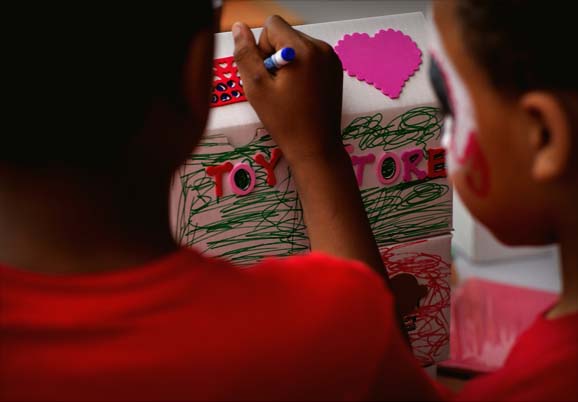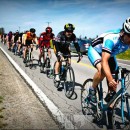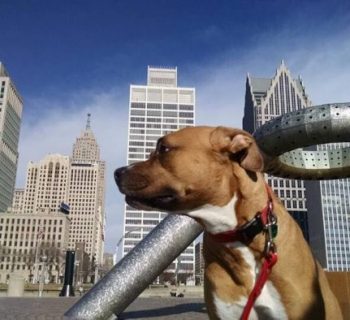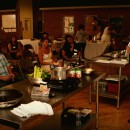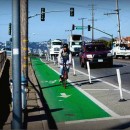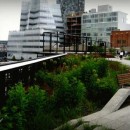DETROIT—Nearly 500 children met the “Mayor” and “Zoning Commissioner” of the Jefferson Chalmers neighborhood during Jazzin on Jefferson, and many set about making it a better place with the addition of a three-story toy shop, a dog park, an Apple computer store, a veterinary clinic, a candy counter and a lighthouse, among other wishes.

A giant tent in the center of the festival contained Box City, an urban planning game for children to learn how to build thriving neighborhoods with kids needs front and center. This is the first time the game has come to Jefferson-Chalmers.
“We nudge without giving answers, we guide with things that make sense for people and places,” said Russell Lacoursiere, volunteer mayor and a LEED certified architect planner for the downtown Detroit architectural firm Gensler.”
Children applied for a zoning permit from Katrina M. Dixon, an early childhood educator who gives time annually to help welcome kids to Jazzin on Jefferson. She has loud, swift words for parents who tried to do their children’s work so it looked better: “Let your little ones make their own buildings. They won’t learn if you do it for them,” cautioned Dixon, who reveled in her role of the neighborhood gatekeeper. Her friendly voice filled the tent with authority and encouragement.
Communicating Arts Credit Union and the Junior League of Detroit sponsored the Box City project and helped subsidize hundreds of boxes, cones, spools, crayons, colored paper and pencils to help children make a scale-model city. Cubes of varied sizes and shapes come from the nonprofit Center for Understanding the Built Environment (CUBE) in Kansas City. The game drew children from Waterford, Grosse Pointe Park and the immediate neighborhood.
“This is part of our overall plan to use arts to foster new development,” said Josh Elling, executive director of the Jefferson Avenue Business Association. The community welcomed 15,000 people in two days to hear live jazz, eat pizza and browse the pop up stores, River’s Edge Gallery East, D:Hive, Goodwell’s, Myra’s Sweet Tooth and Angela Foster’s Coffee and (______).
The coffee shop will open every day from 7:30 a.m. until 3 p.m. until July 6.
All the pop up stores will continue their outreach into July, but the Box City project folded up Saturday with numerous photographs, notes and memories created by children sporting clown, skull and cat faces from the near-by face-painting tent. Their parents and the adult volunteers watched over their progress. During most hours it was packed to capacity with budding planners.
Their canvas was an 8-foot by 12-foot plywood horizontal map of the neighborhood, from its marinas and waterway to industrial plants. Children had to choose what they would build, get permission for their idea, execute their design and decide whether it should be located in the designated retail district, residential homes or somewhere in between.

“You want to make a vet clinic?,” Lacoursiere asked Robert, a 10-year-old boy who lives a few blocks from Jefferson and Conner. “We already have a vet clinic. What else would you like?”
“How about a hospital for humans?,” Robert said.
“Very good idea, Robert,” said Lacoursiere, tirelessly affirming each child’s vision.
From noon to 5 p.m. on Saturday children streamed in with their ideas.
“I want to put a hotel right here,” Brookyn, age seven, said as he plopped his triple-decker box in the middle of the neighborhood.
“If you were a guest of the hotel, would you like to walk to the toy store and the pizza parlor?” Lacoursiere asked.
“Um yeah,” Brooklyn said, moving his box to the retail strip.
“I’m going to make a bike ramp,” said another child.
“Could we improve on this idea,” Dixon said. “How about a bike store? You could put a bike ramp next to it. For customers.”
Soon the whole tent buzzed with excitement.
TheCUBE concept, begun in 1983, brings together educators, architects and community planners to enable children to understand and play a part in the environment they inhabit. It has been recognized by the American Institute of Architects, the National Trust for Historic Preservation and the National Endowment for the Arts.“We need to pay attention to our children. They want a place for veggies. They want safe neighborhoods. They want places to play,” Lacoursiere said.
Going forward and backward on the avenue
Children and adults alike would enjoy seeing a thriving business and residential district along the east end of Jefferson Avenue, according to Josh Elling, executive director of the Jefferson Avenue Business Association.
“The pop-up businesses performed well,” he said, speaking of the crowd-pleasing festival which enjoyed its 10th year of activities. The River’s Edge Gallery East, a staple of the Wyandotte cultural scene, now occupies space that was a shuttered liquor store and known trouble spot. It is star of a gallery crawl this Thursday with events continuing this weekend and two more weekends. Expect to find food samples and fun activities for children on the sidewalks.
The ardent hope, according to Elling, is that some of the pop-ups become permanent stores, drawing more artisans and young families to the neighborhood to occupy its abundant brick homes within walking distance of parks and the Detroit River.
Concurrently the neighborhood celebrates its past. Inside the D:Hive pop-up, Nick Sinacori, author of “Men, Horsepower and Machines,” sold copies of his hardbound book underwritten by a grant from the Motor Cities National Heritage Area. The neighborhood once served as the epicenter of automotive and horse racing.
“We’re looking back at what a great history our neighborhood enjoyed and projecting a positive image of what is to be along the east Jefferson corridor,” Elling said


